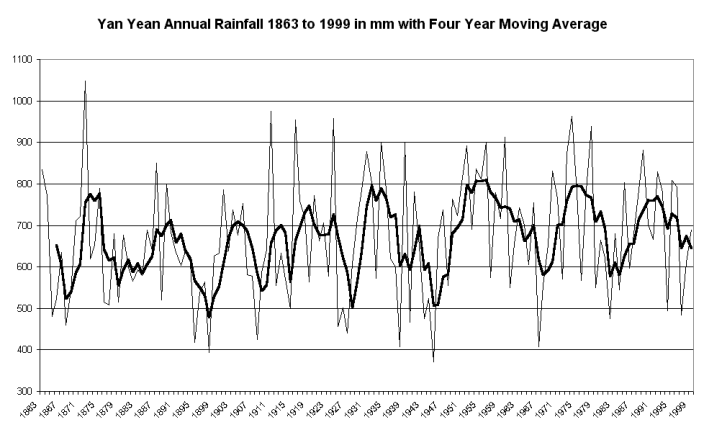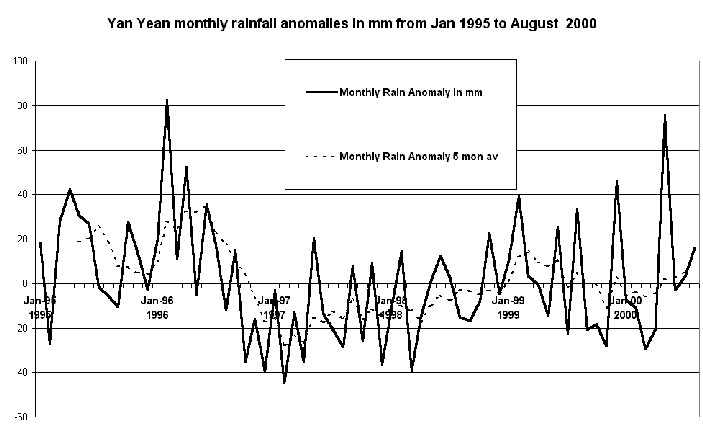Melbourne Rainfall
History
For several months through 2000 Melbourne TV viewers have been
bombarded with advertisements from our water utility, Melbourne
Water, to the effect that, "Melbourne is in the middle
of its worst drought ever."
O.K., we are told that water storage capacity is at
about 55% and rising, as it should be in Spring and if good rains
do not come in next few months than summer water restrictions
could come in.
All sounds reasonable but what are the facts about Melbourne
rainfall.
The graph from Yan Yean on Melbourne's northern
outskirts shows many periods of low rainfall that were
drier than the event we are in now. The Yan
Yean data comes from the Bureau of Meteorology
(BoM) High Quality Rainfall Data Set For
Australia Version 2, Lavery et al 1992, see full
reference below. These data can be downloaded from
the BoM FTP site.

To look more closely at the recent period in question, the
graph below plots monthly rainfall anomalies and it is clear that
from mid 1996 to end of 1998 rainfall was moderately below
average From start of 1999 to end of graph at June
2000 rain has been a little over average but deficient in the
Spring of 1999 when run off could have been expected.

So where does the Melbourne Water statement come from, this
"...........worst drought ever."
part. It might be significant that the BoM High
Quality Rainfall Data above does not contain any stations
from the main area of Melbournes water catchments.
The writer has seen a rainfall record from the catchment area and
the trend over 90 years is for less rainfall compared to the
increasing rain trend seen in Yan Yean.
That both sets of data could be right is doubtful.
Rainfall records can deteriorate for example, by the growth of
trees around the gauge or construction close by. If
factors like these slowly encroach over years then a drift can
set in that renders long term trends incorrect.
Further progress on this problem requires more data from
Melbourne Water's catchment areas.
Clearly if the moderate dry event experienced since 1996
can drop storage levels to 50%, then at current rates of
expanding consumption, Melbournes water supplies will be severely
restricted if a dry spell similar to those experienced in the
1890's, 1920's and 1940's were to strike again.
In order that proper planning can take place and informed
decisions be made, it must be imperative that all relevant data
be publicly available and various issues addressed.
Such as;
- is another dam required ?,
- how could it be built against Green and NIMBY opposition ?,
- without a new dam supplies could be eked out by better use
of waste water, less wasting of water, water restrictions, home tanks,
- clearly there are positives and negatives to the above
measures and how cost effective are they ?
- if Melbourne consumers are eventually going to be put on
semi-permanent water restriction mode, will they enjoy knowing that
"environmental flows" are released from the Thompson Dam ?.
how to balance all these factors.
References
Lavery, B.M., Kariko, A.P., and Nicholls, N., 1992
A High-quality historical rainfall data set for Australia,
Aust. Met. Mag., 40, pp33-39
Nicholls, N. And Lavery, B.M., 1992 Australian Rainfall Trends
in the Twentieth Century, Int. J. Climatology, 12 153-163
You are reading it first here.
Posted 8, September, 2000
© Warwick Hughes, 2000
Back to
Front Page

